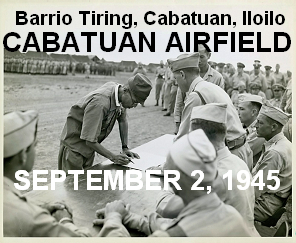
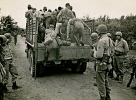

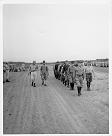


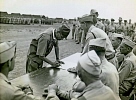
Col. Ryoichi Tozuka signs the surrender instrument
as Col. Raymond G. Stanton looks on.
Cabatuan Airfield
Barrio Tiring, Cabatuan, Iloilo
Panay Island, Philippines, September 2, 1945
|
|
- o -
|
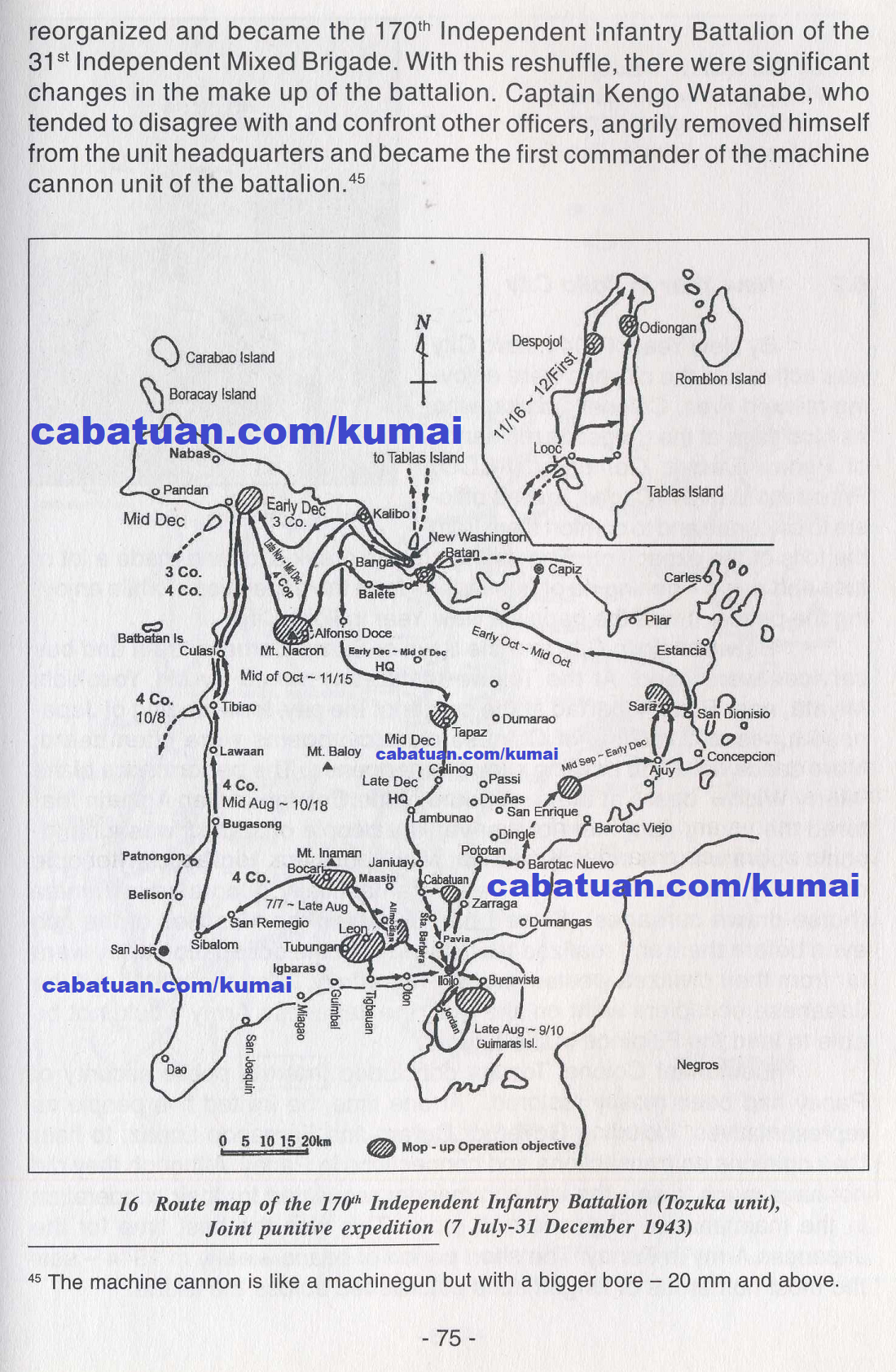
Route Map of the 170th Independent Infantry Battalion (Tozuka Unit), Joint Punitive Expedition (7 July - 31 December 1943). Page 75.
|
|
Chapter 6 – Oppression
6.1 Executions of American Civilians
In December of 1943, as the punitive force was moving south along a tributary of the Aklan River, we bumped into a bushy-bearded American. He was in a torn pair of shorts, bare-footed and limping. Captain Watanabe himself sternly interrogated this man. He identified himself as Mr. King, and said, ‘I used to be a guerrilla officer, but with the Japanese punitive campaigns, my unit scattered. Since I am conspicuously an American, neither the guerrillas nor the locals want to take me in. So I have been wandering along the river.’ From what he said further, Captain Watanabe found out there were more Americans near Egue close to the town of Tapaz, 13 kilometers north of Calinog.
Watanabe immediately dispatched the whole company to Egue and found more than 10 Americans in the village, including a couple of around 50 years of age and their son of 12 or 13. From their interrogation, we learned that there were still more Americans further in the mountains, and my platoon was sent to capture them.
The men were already exhausted, but I encouraged them. We strained to march in the dark, sometimes crawling as we made our way with a local resident as guide. When we reached the village, all residents, including the Americans, had already disappeared. We managed to return to the field headquarters at midnight and slept like the dead under the hut. Next morning, when the company was getting ready, there were no Americans in sight. I asked an NCO attached to the unit headquarters, and he told me, ‘Captain Watanabe executed them all.’ I had thought that all the captured Americans would naturally be sent to the internment camp in Manila, so I felt furious about the cruel approach of Captain Watanabe. On hearing the story, my subordinates were all compassionate and outraged: ‘How could he kill the family of three since they were obviously civilians?’
Neither the Battalion Commander Ryoichi Tozuka nor Captain Kengo Watanabe said anything to anybody about the execution of the Americans, probably because of pricks on their conscience. (Later on, I learned that it was Captain Watanabe who reported the capture to officers at the garrison headquarters in Cebu City and that he did the executions following their order. There were rumors that the order was to bury the fact that – unknown to others, including the Manila headquarters – they wanted to avoid the complexity of formal procedures in dealing with these persons and their transport to Manila.)
In March 1946, at the camp for war criminal suspects at Nichols Field, Second Lieutenant Otsuka informed me that this unpleasant incident was big news in the United States and led to the submarine rescue of the remaining Americans in Panay. It caused such strong hatred for Panay war criminal suspects among the American public such that everyone involved was likely to be condemned for execution by the War Crimes Tribunal.
After the capture of the Americans in Egue in Tapaz, we made our way back to Iloilo City on December 31, destroying guerrilla bases along the way.
The companies of Yoshioka and Fujii, who had taken different routes to Kalibo, Capiz also returned to Iloilo through Pandan, Antique. In the mountains near the town of Pandan, the Itsuki squad of 1st Lieutenant Fujii’s company arrested a guerrilla captain, Antonio Romero. He had three daughters, well-known beauties throughout the province of Antique. Impressed by their beauty, staff officer Watanabe insisted that the Nihon Boseki Kaisha (Japan Spinning Company) in Iloilo employ all three.
Thus, the relentless punitive expedition that lasted for a half-year before Manila headquarters announced the subjugation of the Panay guerrillas. The Taga unit was ordered from Antique to Davao on Mindanao Island on December 20, and the 4th Company of our unit led by Yoshioka was sent to replace them in Antique.
During the expedition, the Tozuka unit obtained 1,000 weapons (including some hand-made ones), 10 wireless radio sets, and around 70 guerrilla officers and men. Behind the rather brilliant results, there were numerous deaths of local residents and guerrillas.
A Filipino guerrilla account describes what happened:
It was a gruesome carnival of blood and fire that the Japs celebrated in northeastern Panay. The thoroughness with which they executed their campaign of destruction could be seen by the long rows of leaping flames at night. Houses and inflammable shrubs, talahib [tall thick grasses], and dried forests were ablaze. The bloodthirsty Japs cried for more blood. The Chinese evacuees at barrio Longao in Passi were rounded up and ordered to prepare a sumptuous banquet. After the Japs had their fill, the feat-stricken Chinese, numbering around eighty-six (86), were hog-tied and burned to death in the very house where the Japs feasted. Corpses of men and women, and children were strewn along the mountain trails in Dumarao, Passi and Barotac Viejo. In the municipality of Sara, only one person out of the entire population of a barrio survived the samurai [traditional Japanese sword]. In another massacre, forty-eight men, women and children who sought refuge in the last retreat atop the Yating mountains were ruthlessly murdered.
This account also provides records on the guerrillas: The number of the deaths of civilian residents was 10,042 between July and until the end of December 1943.
During this time, the guerrillas had been ordered by Mac Arthur’s headquarters to avoid major battles against the Japanese Army. The 6th Military District led by Colonel Peralta strictly observed this order because they lacked ammunition and weaponry. For the preservation of their forces and resources, they adopted the ‘Lie Low’ policy. This meant that the guerrillas hid behind the local people while being prohibited from leaving the area of their garrison. They threatened the local people with execution if they gave away information on the guerrillas to the Japanese Army who demanded it. Therefore, from both sides, the victims were the local residents.
Governor Confesor was critical of Colonel Peralta’s ‘Lie Low’ policy. It seemed childish since it only forced sacrifices on the part of common citizens. In effect, the guerrilla army was negligent or unable to protect the people being killed, avoiding even ‘small battles’ to help them. Hence, the two heroes of anti-Japanese forces in Panay were on bad terms, and later on, even caused the guerrilla hunt for Governor Confesor.
The Kinoshita unit in Capiz and the Taga unit in Antique fared badly in comparison with these accomplishments of the Tozuka unit. Both units saw little action during the expedition. For this reason, they had fewer victims and counted not as many deaths or wounded among their soldiers. Unit commander Kinoshita was sent back to Japan after the expedition since, apparently, his deeds did not satisfy the headquarters. Lieutenant Colonel Kanji Tanabe, who used to have conflicts with staff officer Colonel Watanabe at the Cebu headquarters, replaced him. Lieutenant Colonel Tanabe was my battalion commander during the capture of Bataan Peninsula.
The war accomplishments of the Tozuka unit made Captain Kengo Watanabe famous. However, contrary to his celebrity status outside, he was isolated within the unit.
At the end of December 1943, my unit – the Tozuka unit or the 37th Independent Infantry Battalion of the 11th Independent Garrison Unit – was reorganized and became the 170th Independent Infantry Battalion of the 31st Independent Mixed Brigade. With this reshuffle, there were significant changes in the make up of the battalion. Captain Kengo Watanabe, who tended to disagree with and confront other officers, angrily removed himself from the unit headquarters and became the first commander of the machine cannon unit of the battalion.
|
|